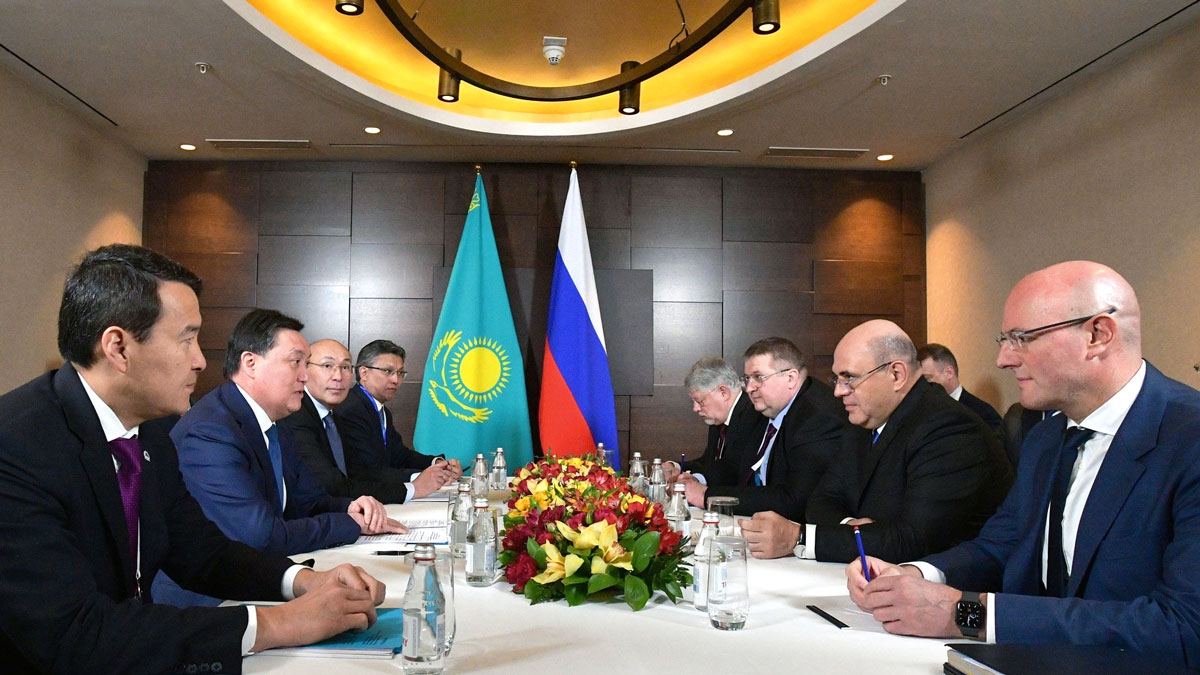Kazakhstan, Energy Hub for China and Europe
Kazakhstan becomes a major energy destination for China and the West, given the increased demand for oil and gas in the near future.
At the recent high-level bilateral meeting between Kazakhstan’s Prime Minister Askar Mamin and his Russian counterpart Mikhail Mishustin, the two countries signed a Memorandum of Understanding meant to continue the construction of energy corridors to China and Europe and establish the production infrastructure to facilitate the sale of compressed natural gas (CNG).
The two countries also pursue together the prospects of building motorways, as new development vectors, to bring technological innovation and economic development in the regions linking Europe to China. Analysts believe that this transport route will facilitate the increase in export flows and will bring a huge contribution to the development of economies of the participating countries.
The Europe-Western China-Russian-Kazakhstan transport corridor will link the ports of Finland through the Baltic States, via Kazan and Orenburg (in Russia) and Kazakhstan, to Western China.
Kazakhstan, an unrecognized energy power in an uncertain geopolitical environment
Due to the importance of its oil, coal and uranium reserves, Kazakhstan – the ninth country in the world in terms of surface – plays a significant role in the market of these raw materials. Since it obtained its independence in 1991, its development has been intrinsically linked to the capacity to attract foreign investors, especially American, to exploit its hydrocarbon fields, whose complex technical characteristics required the intervention and expertise of Western companies.
In Kazakhstan, oil accounts for over 80% of the production of “exploitation and extraction” category.
Being the main source of revenue from export, foreign currency reserves, fiscal revenue, and foreign direct investments (FID), the oil and gas sector has a strategic importance for the Kazakh economy. Exports of mineral products accounted on average for 75% of Kazakhstan’s total exports between 2013 and 2020.
Created in 2012 to represent the interests of the state in the oil and gas sector, the national company JSC NC KazMunayGas (KazMunayGas) has several subsidiaries, including KMG Exploration and Production (upstream operator), KazMunaiTeniz (oil and gas fields exploitation company) KazTransOil (pipeline operator) and KazTransGas (gas pipeline operator). KazMunayGas owns stakes in Kashagan (16.8%) and Tengiz (20%) fields, interests between 15% and 100% in several onshore projects.
The increase in oil production was the result of an influx of foreign investment in Kazakhstan’s oil sector since 1991. International investment took place in the form of joint ventures.
Based on the system in force in the former Soviet Union, Kazakhstan’s methods of classification of oil and gas reserves are significantly different from international standards. The declared reserves do not necessarily correspond to the economically exploitable reserves.
Oil
The second largest producer in CIS (Commonwealth of Independent States) after Russia, Kazakhstan has the largest recoverable oil reserves in the Caspian Sea region. According to bp’s Statistical Review of World Energy, its proven reserves amounted to around 30 billion of oil barrels at the end of 2017, i.e., 1.8% of the proven global reserves (with a production capacity of 86.9 million tons), i.e., 2% of the global production capacity.
Tengiz, Karachaganak and Kashagan are the most important oilfields in the country.
Tengiz field, discovered in 1979, is located in Atyrau region, near the north-eastern coast of the Caspian Sea. It is a deposit that the Soviets couldn’t develop, due to the lack of know-how at that time. Established in 1993 to exploit this oilfield, the Tengizchevroil consortium now has as shareholders Chevron (50%), ExxonMobil (25%), KazMunayGas (20%) and LukArco (5%).
The recoverable reserves of Tengiz field are estimated between 750 million tons (5.5 billion barrels) and 1,100 million tons (8.1 billion barrels). Since 2013, three projects have been designed to maintain the production capacity on the existing facilities, to increase the efficiency and reliability of the facilities and increase the total daily output from 250,000 to 300,000 oil barrels. Investments in the second phase of Tengiz development are expected to amount to USD 38bn and its implementation is estimated to increase the capacity of Tengiz field production to 39 million tons of oil per year, by 2022.
The Karachaganak field (KOGCF or Karachaganak Oil and Gas Condensate Field), located in the north-west of Kazakhstan, not far from the border with Russia, is one of the main oil and gas condensate fields in the world. Discovered in 1970, it covers around 280km² and contains over 1.2 billion tons of oil and gas condensate and over 1.3 trillion cubic meters of gas. This field is owned by Karachaganak Petroleum Operating BV (KPO), a consortium consisting of BG Group – purchased by Royal Shell in 2016 – (29.25%), Eni (29.25%), Chevron (18%), Lukoil (13.5%) and KazMunayGas (10%), which signed with the government a production sharing agreement for 40 years.
Most exports run through the CPC (Caspian Pipeline Consortium) pipeline to the Black Sea. Liquids that are not exported by pipeline are sold in the form of condensate on the local markets and the Russian market. The future development of the Karachaganak field is subject to very important investments targeting primarily the maintenance of the current production, then its expansion (the Karachaganak Expansion Project). The level of liquid hydrocarbon production must therefore be maintained within the interval from 10 to 11 million tons per year, its expansion following to allow the treatment of around 4bcm of additional gas per year (which will be reinjected into the reservoir to maintain the level of liquid hydrocarbon production).
Due to investments made by Chevron and ExxonMobil, the US ranks first among the foreign investors in Kazakhstan.
Kazakhstan exports most of its oil production. Since 2000, it has recorded a significant increase in oil exports, which transit mainly Russian pipelines, to the Black Sea ports for the international markets. The main oil companies in Kazakhstan – the Tengizchevroil and KPO consortia – account by themselves around 60% of the country’s total oil export volume.
Natural Gas
According to bp’s Statistical Review of World Energy, a year ago, Kazakhstan held 0.6% of the global gas reserves. These are found especially in the west of the country, near the Caspian Sea (29.7% of the proven reserves are concentrated in the Karachaganak field). Another important source of natural gas is the Amangeldy field in the Zhambyl region of southern Kazakhstan.
In Kazakhstan, almost all natural gas is associated gas, i.e. it is exploited in association with oil. Therefore, many fields inject significant amounts of gas back into the ground to maintain pressure for oil extraction.
Associated gas that is not reinjected is burned, but the Government has asked producers to reduce flaring, since 2005. Since the introduction of these measures, the burned volumes were reduced by more than two thirds. The development of the petrochemical industry to produce polyethylene and polypropylene from associated gas is another priority of the state.
Kazakhstan has two separate gas distribution networks: one in the west, which serves the country’s operational fields, and the other in the south, which mainly supplies natural gas, often imported, to the southern regions.
Government prefers gas to the detriment of coal for thermal power plants and other household uses. Therefore, it has adopted the General Gasification Scheme of the Republic of Kazakhstan, which provides that 56% of the population will have access to natural gas by 2030.
In 2014, the Government approved a permanent program – ‘Concept for the Development of the Gas Sector until 2030’ – whose measures include, inter alia, a pilot project on the extraction of the methane layer in Karaganda region and identification of gas fields to produce liquefied gas, synthetic oils, and methanol or which can be connected to the collection centres of a national operator.
Electricity, coal, and nuclear energy
Exports account for around 5.7% of the total electricity production and are mainly to Russia, Uzbekistan, and Kyrgyzstan. As the electricity transmission and distribution network was integrated into the electricity network of the former USSR, Kazakhstan must adapt and complete its network to unify it in the entire country. The country still imports electricity to supply its western and southern areas. The ‘thermal power plants’ in Kazakhstan, especially the large ones (Ekibastuzskaya GRES-1, Ekibastuzskaya GRES-2, Aksu GRES and Zhambylskaya GRES) are based mainly on coal. Regarding the proven coal reserves, Kazakhstan ranks 8th in the world according to bp’s Statistical Review of World Energy, and in terms of coal production Kazakhstan ranks 10th in the world. It has 10 anthracite and lignite basins and over 300 exploited deposits, located mainly in the Karaganda (60% of the total), Pavlodar (20% of the total) and Kostanaï regions. With an area of over 3,600 km², the Karaganda coal basin is the largest in Kazakhstan, followed by the Ekibastuz basin, located between the Saryarka and Priertysskoy plains.
The national electricity transmission network is a complex network of substations and distribution centres that connect power lines from 0.4 to 1150 kV. It forms the basis of the unified electricity network of Kazakhstan and ensures connections between various regions and with the energy systems of the neighbouring countries (Russia, Kyrgyzstan, and Uzbekistan), as well as the electricity transmission between the power plants and consumers in the wholesale market.
Kazakhstan accounts for around 40% of the natural uranium production in the world and has the second largest reserve.
If we talk about uranium, Kazakhstan is global leader, with approximately 40% of the global production and has the second largest reserve in the world (estimated at around one billion tons). Uranium production in Kazakhstan reached 23,391 tons in 2017 and the exported volume (in the form of concentrate) was 23,200 tons. The state-owned company JSC National Nuclear Company Kazatomprom (uranium producer) and its subsidiaries alone produced 12,134 tons of uranium.
Kazatomprom operates 26 basins grouped into 13 treatment centres, both directly and through the numerous joint-venture-type subsidiaries. To be noted in particular is KATCO, with the French company Orano (formerly Areva), which operates the Muyunkum site, the largest ISR (In Situ-Recovery) uranium mine in the world. This in situ recovery technology allows uranium extraction with a reduced environmental impact. As by-products, Kazatomprom also sells beryllium, tantalum, and niobium, which are among the rare metals.
Today, Kazakhstan no longer has an active capacity of nuclear energy production: its only power plant – the sodium-cooled fast reactor (SFR) BN-350 located in the Mangystau region, near Aktau – ceased its activity in 1999, after 26 years of operation, and was decommissioned in 2001. However, in 2014, given the importance of uranium production, President Nazarbayev asked the Government to create the company JSC Nuclear Power Plants, which, in collaboration with Kazatomprom, is preparing a feasibility study to build two nuclear power plants. The first would be planned near the town of Kurchatov, to the south-east of Pavlodar on the Irtysh River (north-east of the country) and the second near the town of Balkhash, located on the lake with the same name in the Karaganda province (in the south of the country). Their construction should start after 2025. A preliminary agreement was signed with the Russian company Rosatom.
Kazakhstan: A strategy at the mercy of its major neighbours?
Kazakhstan, which rightly takes pride in the presence in the ground of 99 of the 100 items in Mendeleev’s Table, is therefore naturally positioning itself as an exporter of these raw materials. However, it suffers from the isolation between the two very strong neighbours in the north and the east, Russia, and China, and those in Central Asia, in Kyrgyzstan, Uzbekistan and Turkmenistan.
Moreover, its area is almost 3 million square kilometres, at a population of only 18 million inhabitants scattered around its periphery. Inheriting the infrastructure built during the Soviet period, the country must bear colossal costs both to modernize it and to integrate it into its vast territory. It is therefore imperative to reconcile with its neighbours to export its raw materials, which are subject to significant transport costs.
Natural gas, fuel on the international transport route Europe – Western China
The ministries of Energy in Russia and Kazakhstan aim to promote the market of fuels for vehicles using natural gas and create a gas supply infrastructure network on the international routes in the following years.
Therefore, Russia’s energy minister Nikolay Shulginov and his Kazakh counterpart, Magzum Mirzagaliyev, have signed a Memorandum of Understanding in the field of infrastructure development for the use of natural gas as fuel on the international transport route Europe – Western China.
Joint action plan
A joint action plan was signed to develop the road infrastructure of the Europe-Western China route and the Meridian highway as well. The Europe-Western China transport corridor will allow locations along the route to be linked to transcontinental transportation and earn revenues from the transit traffic passing through their communication arteries. Transport will become a priority for the economy, as the share of transport services in the gross domestic product, may attract revenues and investments in the development of other economic sectors too.
Currently, in Kazakhstan, many hopes rely on building the Europe-Western China route to bring energy on international markets. According to Talgat Arystanbaev, chairman of the Natural Gas Vehicles Association Kazakhstan, the measure will lead to building 100 CNG (compressed natural gas) and LNG (liquefied natural gas) stations across the country.
Currently, China owns a 24% stake in oil production and 13% in gas production in Kazakhstan. Observers believe that Kazakhstan, together with Turkmenistan, will remain important partners for energy exports to China in the future. Moreover, China has quickly built five dams in the Almaty region to produce 480 MW of electricity. It will be the largest Chinese hydropower project in Central Asia. The Kazakh authorities are also holding discussions with the Russian energy company Rosatom for the potential construction of a nuclear power plant.
Optimism in Kazakhstan
Officials believe that this transition stage is necessary due to commitments to reduce carbon emissions not only by giving up coal, but also by switching to a new economic model for electricity production.
Kazakh officials say that their optimism comes from the “favourable price conditions” on the global markets, which they believe that will help increase revenues from export of metals and metal products. The Organization of Petroleum Exporting Countries (OPEC) has set a quota of 1.5 million barrels of oil production per day for Kazakhstan in December 2021, an increase of 16,000 barrels. The Eurasian Development Bank (EDB) analysts expect oil production at the Tengiz field to increase in 2023, which will help Kazakhstan’s gross domestic product (GDP) to grow up to 5% in 2023.
Kazakhstan government resigns following fuel price protests
Kazakhstan’s President Kassym-Jomart Tokayev has sacked his cabinet and imposed states of emergency in the country’s largest city and an oil-rich western region following mass protests triggered by a rise in fuel prices, foreign media inform.
Tokayev announced he had accepted the resignation of the cabinet led by Prime Minister Askar Mamin and ordered the acting cabinet to reinstate price controls on Liquified Petroleum Gas (LPG). He also ordered the acting cabinet to broaden price controls to petrol, diesel and other ‘socially important’ consumer goods.
The protests broke out in the town of Zhanazoen in the western Mangistau region on January 2, a day after the government lifted caps on prices for Liquified Petroleum Gas (LPG). Mangistau depends on the comparatively cheap LPG as the main fuel for automobiles and the AFP news agency said any jump in prices would have affected the price of food, which has seen steep increases since the beginning of the coronavirus pandemic.
The protests quickly spread to other parts of Mangistau and western Kazakhstan, including the provincial centre, Aktau, and on to Almaty and the national capital, Nur-Sultan.







